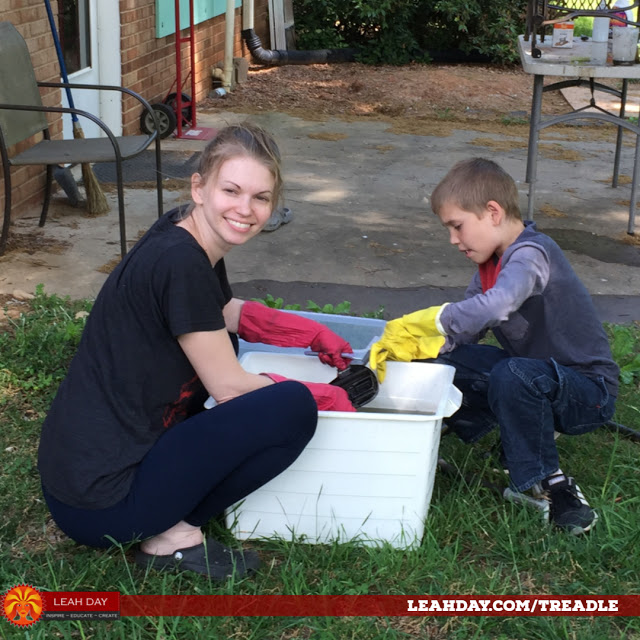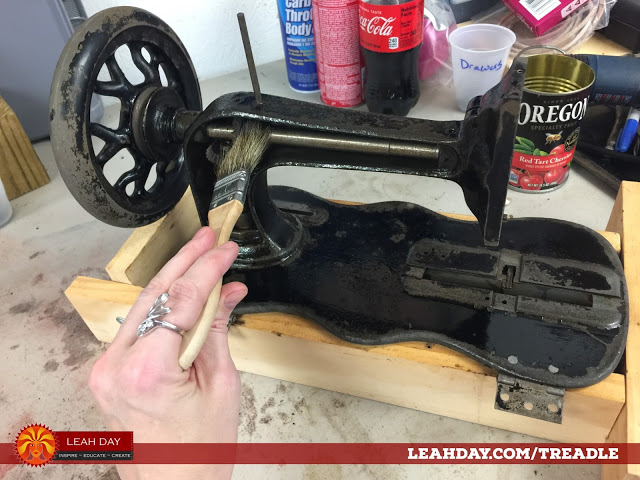Scrubbing a Singer in the Sun
Thank you all so much for your kind compliments on my flowered hat for the derby party! It’s funny, I often find the anticipation of parties – getting ready, making the hat, planning the design, etc. is more fun than the actual event. It’s yet another reminder to enjoy the journey, not the end result.
Now I have a really pretty hat to wear around. Who knows, I may just pop it on when I’m having a bad hair day and wear it to the grocery store!
Today has been such a busy, wonderful day. We started a game of monopoly in the morning, then paused it to go outside and play. I’ve been soaking my dismantled Singer 12 in apple cider vinegar since Thursday and it was high time it came out of the rust bubble bath and got a solid scrub down.
 |
| Yes, today was 100% a messy hair day! |
I plan to post a detailed step-by-step tutorial on this whole process later, and I’ve been stocking up hoarding photos for that and it’s been driving me crazy. I like sharing what I’m working on WHEN I’m working on it!
So I’ve decided to just share the photos and tell the story and link it all up nicely in the end. It’ll work out one way or the other.
I know it sounds crazy to soak a 130+ year sewing machine in vinegar, but I was told by someone who thinks they know everything that it’s the best possible way to remove the rust from the machine. It was also a great way of removing a lot of the loose paint and all the dirt too!
I enlisted James’s help and together we scrubbed it down with toothbrushes and baking soda to stop the vinegar reacting with the metal. Then we dunked it, scrubbed it, dunked it, scrubbed it, again and again and again.
It is really amazing just how nicely simple apple cider vinegar cleaned up this machine! As soon as I rinsed the machine for the last time, I dried it off quickly then began oiling it with sewing machine oil. All the exposed metal will immediately rust again unless it’s coated completely in oil or primed and I wasn’t in the mood to paint today after all that scrubbing.

Now I know this looks really rough, but at least it’s clean. When I first opened up the machine, the bugs inside made me do the creepy crawlies dance a few times before I could settle down and get back to taking it apart.
And I FINALLY got the bobbin plates off! VICTORY! These were so caked with rust I was wondering if they would ever come off the machine. I gently tapped with a screwdriver and hammer and they slowly, stubbornly slid away from the center (I may have started hitting a bit harder after a few gentle taps).
Both plates are soaking in more vinegar because they have even more rust on the sides that I couldn’t access while they were stuck on the machine.
So that’s what I was working on today! It was so nice to be outside in the sunshine and I feel like this treadle machine is one step closer to coming back to life. What have you been working on today? Have you caught VMO yet?
If you’re reading this, I’m sorry to say, you are probably already infected. Vintage Machine Obsession is extremely contagious!
Let’s go quilt,
Leah Day

I have been infected for 7 years. I have a treadle and a slew of vintage Singers that I do all my sewing with. Yahoo groups with people like Cheryl, have taught me so much. If you want to keep the paint finish on a machine, you can't soak it in vinegar as the clearcoat will be damaged. However, if tine paint is compromised and you want to repainted, ok. I took all the metal parts off a Lotus Singer and soaked them in vinegar and it worked well. I did not want to lose the wonderful decals, so I used Krud Kutter on a rag to clean the paint. Then polished. Congratulation, the straight stitch on those machines can't be beat!
We were WAY beyond saving the paint on the Singer 12. The decals had been lost years ago, though they left a faint impression on the remaining paint. I might search for similar decals to replace them or just go with a brand new paint color. I'm still researching that phase as it's a bit terrifying! LOL!
I have it too. It started when I found an old Featherweight (1940s) in my MIL’s garage. It wasn’t rusty like yours, but it was all gummed up. I enjoyed very much cleaning it and returning it to working order. I don’t know what I’ll DO with it, but it runs like a champ.
May that little Singer be the first of many! I started in November 2016 with a little 1930s 99K handcrank which had one lady (sadly departed) owner – it has a fantastic history and travelled the world! The name is Pat after her owner – and because she has an ejector button for the bobbin – she is now Bond, Pat Bond! She was in exceedingly good condition and just needed a quick clean and oiling. I took her on holiday with me last year. Unfortunately it didn't stop there. My mother used to have a treadle 15K which she swapped for an electric one. It belonged to my grandmother and I was devastated – it had the heavy iron base too. So as soon as I saw a treadle that looked reasonable I saved her. I don't know the history but she's another 1930s girl with the RAF decals and has wooden legs, not the cast iron. I called her Vera after the wartime entertainer – she sews lovely and I made a quilt top yet to be quilted. A Singer 128K soon followed. An old and slightly battered Victorian lady. Previously a family hand-me-down that needed a home as the family didn't want her. So she came home with me – previous owner was Vera, so I couldn't call her that. Friend said she should be called Pearl! LOL! So she's Lady Pearl Verah – very posh! After that I thought I could tempt my daughter to join me so I acquired a German Hengstenberg Anker complete with seagulls and a steam sailing ship (she likes all things nautical) – nope, not enough to convert her, so I'm toying with a name – possibly Odette. I then found a 201K (also 1930s) treadle. The smartest of the old Singers, now named Agent Peggy Carter as I don't know of her history. I said I'd stop when I found one with mother of pearl. I did – briefly! – and her name is Rose. Another German girl, around the late 1890s with the most splendid walnut box – I think it is another Hengstenberg from photos of the style and box. I purchased a Featherweight 221K 1955 to go on a quilting retreat. Her owner was Molly so Molly she became. Then finally, for my birthday this year I had a machine, Vesta, with my name on the decals! The date inside the lid has been handwritten May 1925 – naturally she is Mini-me! She can be adapted for treadle use – perhaps I can do the same with the others. So NO more machines! I have enough to play with (not sure about Rose, I still need to work on her) and the others are perfectly fine to rotate. I'm hoping to get to quilt with Peggy when I get round to it – moving house, hoping to have a proper studio made from the outbuildings to play in at a later date.
Meanwhile write 100 times I must not be tempted, I must not be tempted . . . . I'll tell you if I fail! LOL!
So enjoy your new machine – I really, really love them all. Hate the thought of them being thrown on a scrap heap! And well rescued from the rust! 😀
I too have this infection but on a smaller scale. I’m infected with The Featherweight Bug! I was given one from my Aunt after she passed away and I love it. Such a tough little machine. I do own a Singer treadle base that was my husbands, grandmothers. I made it into a small table. I found my sister a Singer 66 yesterday in beautiful condition which she bought.
Love your videos and information on these beautiful old machines.
My husband bought me two Singer Treadles for my birthday last December. One was seized up but I used WD40 on the rusted parts and this removed the rust easily and then re-oiled all the bits with Singer (or equivalent)sewing machine oil. Belts, rubber rings for the bobbin winder and decals can be bought on the internet. There is a very good Singer sewing machine site on the internet (UK) and this man has spare parts and the history of Mr Singer himself. All Singers have a serial number and you can put this number in and find out the month and year,where and how many were made. Hope this helps. Regards Helen
I have four treadle machines, and ten total VSM’s. I used your darning foot tutorial to change a clear Baby Loc foot for FMQ on one of my class 15 machines, though with a low shank, it really works with 8/10 of my old girls. Bonnie Hunter got me started. They are so soothing to sew on. I can’t wait to see your 12 in action. That is one I would live to find.
I have an old Singer that is coated with cigarette smoke. This machine has all of the decals and they are in good shape. Did you take the tension disks apart? How can I protect those decals? It appears that you are down to just a frame. My husband gets very upset with me when I dismantle something and then forget how I took it apart. Is it easy to put back together?